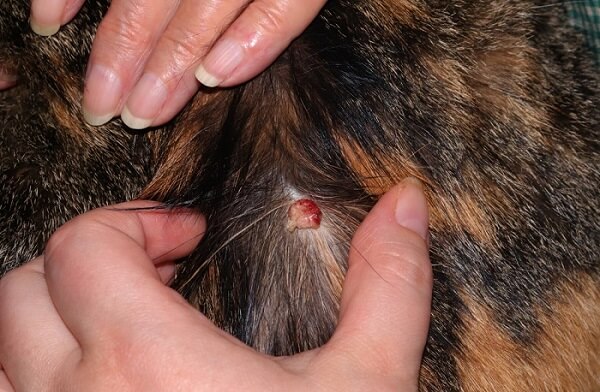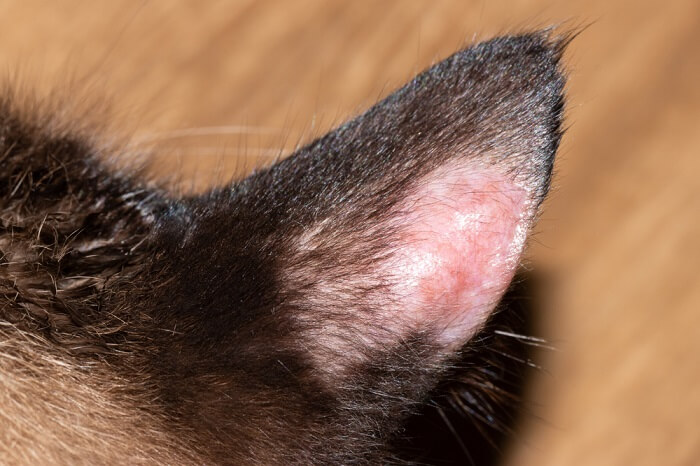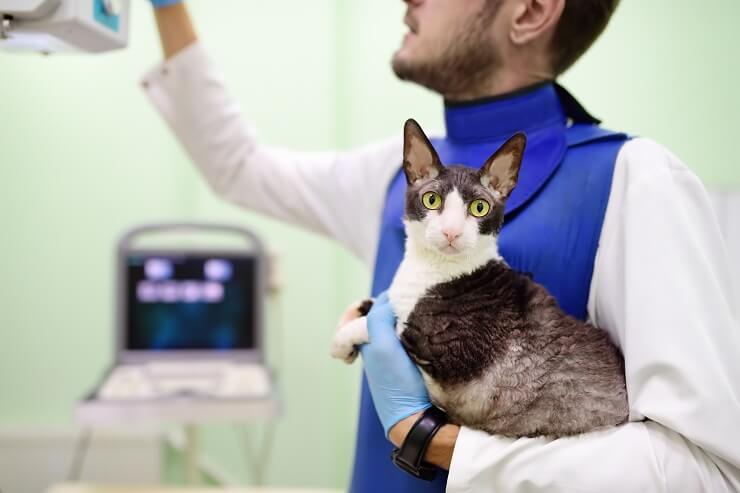
When you find a new lump or lesion on your cat, it can be quite scary. It could be anything from an injury (e.g. cat bite abscess) to something more serious, like a tumor.
There’s lots of different types of tumors that cats can get, but in this article we’re going to talk about a particular skin tumor called histiocytoma. By the end of this article, you’ll know everything you need to know about histiocytomas, how to recognise them and what to do about them.
Quick Overview: Skin Tumours (Histiocytoma) In Cats
 Common Symptoms: Small, round, raised, usually hairless lesion on the skin. Sometimes red and ulcerated. May appear quickly. Head, ears, and limbs are most common locations.
Common Symptoms: Small, round, raised, usually hairless lesion on the skin. Sometimes red and ulcerated. May appear quickly. Head, ears, and limbs are most common locations.
 Diagnosis: Fine needle aspirate for examination of cells under a microscope (cytology). Surgical removal for tissue biopsy may also be considered, especially if the growth is infected, ulcerated, or irritating.
Diagnosis: Fine needle aspirate for examination of cells under a microscope (cytology). Surgical removal for tissue biopsy may also be considered, especially if the growth is infected, ulcerated, or irritating.
 Requires Ongoing Medication: No
Requires Ongoing Medication: No
 Vaccine Available: No
Vaccine Available: No
 Treatment Options: Histiocytomas typically regress on their own within 3 months. If it does not, or if the growth is infected, irritating, or ulcerated, surgical removal is typically curative.
Treatment Options: Histiocytomas typically regress on their own within 3 months. If it does not, or if the growth is infected, irritating, or ulcerated, surgical removal is typically curative.
 Home Remedies: None
Home Remedies: None
Skin tumor (or histiocytoma as we’ll call them in this article), are small skin lesions that occur commonly in young dogs. Retrievers and boxers are particularly prone. They’re rare in cats, yet they can develop and there’s no known breed, age or gender that makes them more prone to developing them.
The good thing about histiocytomas is that they’re benign skin tumors. Benign tumors don’t infiltrate other tissues (metastasis) or cause systemic illness. This means that they are non-cancerous and aren’t going to cause an issue for your pet. However, cats can develop all sorts of lumps, bumps and cysts, some benign and unfortunately some malignant tumors (cancerous).
It’s important to rule out malignant tumors which can also occur in cats e.g. melanoma, leukemia, mast cell tumor, histiocytic sarcoma etc. Certain skin diseases can also develop nodule like skin lesions which could be mistaken for tumors. For this reason, it’s important to take any new lumps seriously and to get them checked out by your veterinarian to determine what sort of lump it is.
What Are Histiocytomas?
They’re small skin lesions that develop from an abnormal proliferation of histiocytes in the skin. More specifically, they originate from Langerhans cells (a specific type of histiocyte), that has a role in the immune system. These cells produce a protective immune function for the skin, hence why these lumps are often present on the skin surface (cutaneous lesions).
Histiocytomas aren’t to be confused with histiocytic disorders, which again are more common in dogs. These include malignant histiocytosis, cutaneous histiocytosis, systemic histiocytosis, histiocytic sarcoma and histiocytic lymphoma. Though they sound similar, these conditions are less benign and more malignant than histiocytomas and need to be taken very seriously.
Symptoms of Histiocytomas

Histocytomas can present differently but hairless lesions are one of the usual signs.
These benign tumors can present differently but usually have the following characterizations;
- Small, round, raised lesions on the skin
- Fast growing
- Hairless lesions
- Usually solitary (but can occur in multiples)
- Less than 2.5cm in diameter
- +/- red surface area (sometimes with ulceration)
- Not usually painful
Histiocytomas don’t cause a cat to feel unwell or ill and often you won’t notice any other symptoms besides the appearance of a skin lesion. If your cat is unwell or showing other symptoms along with a histiocytoma skin lesion, consult your veterinary clinic.
How Do We Know if It’s A Histiocytoma?
If you notice a skin lesion on your cat, it’s vital to bring them to your veterinary clinic. Your veterinarian will take a full history from you, including the timing of when the skin lesion(s) appeared, if it has changed in size or appearance and if your cat has been irritated by it. They may want to carry out blood and urine testing to check your cat’s overall health and to see if there’s any underlying conditions.
Your veterinarian might have a suspicion that the lump is a histiocytoma from the history and appearance, but if you want more reassurance (as we often do with the sudden appearance of a skin lump), further tests are required.
Your vet can do a fine needle aspirate (needle biopsy), which is when they put a needle into the lump and aspirate some of the cells back through a syringe. They then put these aspirates on a slide and send them to the laboratory for analysis (cytology).
On cytological evaluation, round cells may be seen along with plasma cells, neutrophils and lymphocytes. Sometimes this will provide an answer if the cell harvest is adequate and if enough cells can be visualized well, but this isn’t always the case.
Another option is the surgical removal of the tumor and to send the entire lesion away for examination by a pathologist (histopathology). This option will differentiate between a histiocytoma and other tumor types, hence giving a definitive diagnosis.
Treatment – How Do We Treat Histiocytomas?
If your pet’s lump is a confirmed histiocytoma (see above), you have a couple of options. You can opt to get the lump removed, surgical excision is usually curative. If you have confirmed the lump is a histiocytoma through this method, no further treatment is normally needed. This can be done through surgery or cryotherapy.
The other option is to wait and see if the tumor goes away on its own, this can occur in 2-3 months. If tumor regression hasn’t occurred by 3 months, then I would recommend that it should be removed.
Of course, the safest and most reassuring option, is to get the lump removed sooner if your cat is a good anesthetic candidate. You can discuss this with your veterinarian and make yourself aware of all the pros and cons.
Monitoring

If your cat has been diagnosed with benigh skin tumor, one of the options is to wait and see if the tumor goes away on its own, this can occur in 2-3 months.
Histiocytomas as we’ve already mentioned, are benign. This means we don’t need to worry about them causing a problem (after we’ve confirmed they’re histiocytomas). However, they should be monitored regardless as any lump or bump can get traumatized, for example if the cat scratches it or if it get’s bumped off something. This can cause irritation and may even cause a superficial skin infection.
If the histiocytoma is removed, you should continue to check your cat’s coat regularly in case any new lumps occur. These should be checked by your veterinarian if this occurs, as a new lump doesn’t necessarily mean it’ll be the same as the last one (histiocytoma).
As always, pet owners should continue to monitor their pets for any new symptoms (change in appetite, weight loss, increased drinking or urination etc.) or a change in behaviour as these might indicate a different problem. Usually, histiocytomas don’t produce any of these symptoms.
Take Home Message
A skin tumor (histiocytoma) can be a worrying thing for an owner to find. Luckily, they’re benign tumors and surgical removal is curative. They usually regress within a few months on their own but it’s vital to get any new lesions checked with your veterinarian to rule out malignant tumors.
You can discuss all the options with your veterinarian after the histiocytoma has been diagnosed, but the good news is that these lumps aren’t cancerous and won’t make your cat unwell.
Frequently Asked Questions:
Can cats get histiocytoma?
Yes they can. Histiocytomas are rare in cats and more common in dogs but they can occur. They have no known breed, sex or age predilection.
Are histiocytomas cancerous?
No, histiocytomas are benign skin lesions that don't spread or infiltrate other tissues.
How will a histiocytoma go away?
Usually, histiocytomas regress within a couple of months. You may notice the lump becoming smaller and smaller. If not, they should be checked again by your veterinarian.
When should histiocytoma be removed?
Histiocytoma lesions can be removed at any point as they're small, but usually early removal is helpful to achieve a definitive diagnosis and for peace of mind.







